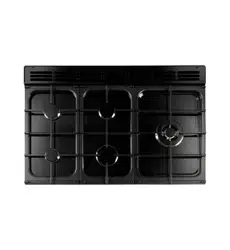Loading ...
Loading ...
Loading ...

8
The Glide-out Grill
CAUTION: Accessible parts may be hot when the grill
is in use. Young children should be kept away.
Open the door and pull the grill pan carriage forward using
the handle (Fig. 2.15).
The burner does not glow red when in use; food cooks from
the heat of the ame. The rst time you light the grill there
may be a little smoke given o – this is perfectly normal.
Operation
The grill has a special safety device which stops the ow of
gas if the ame goes out.
To turn on the grill, press the igniter button and then press
and hold the grill control knob to the large ame symbol (
)
for about 10 seconds (Fig. 2.16).
If, when you release the control knob the burner goes out,
then the safety device has not held in. Turn the grill control
knob to ‘0’ and wait for one minute. Repeat the operation but
hold the button and control knob in for slightly longer.
The low position, marked with the small ame symbol, is
beyond high, not between high and o (Fig. 2.17).
For best results, slide the carriage back into the grill chamber
and preheat the appropriate part(s) of the grill for two
minutes. The grill trivet can be removed and the food placed
on it while you are waiting for the grill to preheat.
DO NOT leave the grill on for more than a few
moments without the grill pan underneath it,
otherwise the knobs may become hot.
Once the grill has preheated, slide the carriage out again.
With the trivet back in place with the food on it, slide the
carriage back into the grill chamber. Make sure that it is
pushed right in.
The grill pan trivet can be turned over to give two grilling
positions (Fig. 2.18).
Do not leave the grill on for more than a few moments,
without the grill pan underneath it.
Never close the grill door when the grill is on.
ArtNo.331-0002 Grill pan high/low position
ArtNo.331-0001Grill pan pulled forwards
Fig. 2.15
Fig. 2.16
Fig. 2.17
Fig. 2.18
Loading ...
Loading ...
Loading ...
